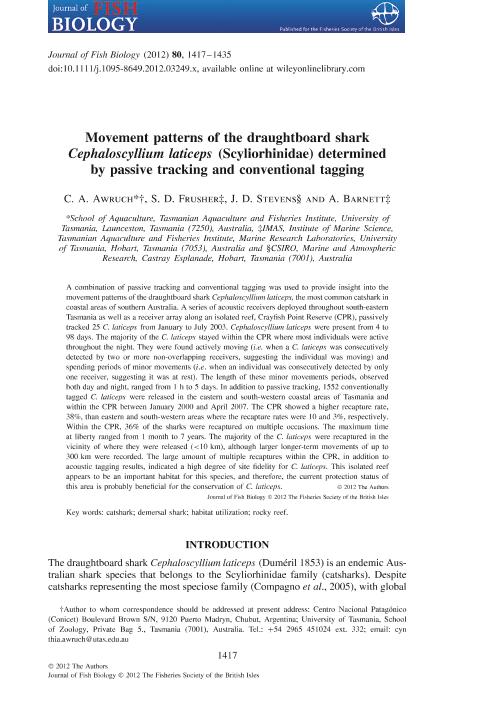Artículo
Movement patterns of the draughtboard shark Cephaloscyllium laticeps (Scyliorhinidae) determined by passive tracking and conventional tagging
Fecha de publicación:
04/2012
Editorial:
Wiley Blackwell Publishing, Inc
Revista:
Journal of Fish Biology
ISSN:
0022-1112
e-ISSN:
1095-8649
Idioma:
Inglés
Tipo de recurso:
Artículo publicado
Clasificación temática:
Resumen
A combination of passive tracking and conventional tagging was used to provide insight into the movement patterns of the draughtboard shark Cephaloscyllium laticeps, the most common catshark in coastal areas of southern Australia. A series of acoustic receivers deployed throughout south-eastern Tasmania as well as a receiver array along an isolated reef, Crayfish Point Reserve (CPR), passively tracked 25 C. laticeps from January to July 2003. Cephaloscyllium laticeps were present from 4 to 98 days. The majority of the C. laticeps stayed within the CPR where most individuals were active throughout the night. They were found actively moving (i.e. when a C. laticeps was consecutively detected by two or more non-overlapping receivers, suggesting the individual was moving) and spending periods of minor movements (i.e. when an individual was consecutively detected by only one receiver, suggesting it was at rest). The length of these minor movements periods, observed both day and night, ranged from 1 h to 5 days. In addition to passive tracking, 1552 conventionally tagged C. laticeps were released in the eastern and south-western coastal areas of Tasmania and within the CPR between January 2000 and April 2007. The CPR showed a higher recapture rate, 38%, than eastern and south-western areas where the recapture rates were 10 and 3%, respectively. Within the CPR, 36% of the sharks were recaptured on multiple occasions. The maximum time at liberty ranged from 1 month to 7 years. The majority of the C. laticeps were recaptured in the vicinity of where they were released (<10 km), although larger longer-term movements of up to 300 km were recorded. The large amount of multiple recaptures within the CPR, in addition to acoustic tagging results, indicated a high degree of site fidelity for C. laticeps. This isolated reef appears to be an important habitat for this species, and therefore, the current protection status of this area is probably beneficial for the conservation of C. laticeps.
Palabras clave:
Catshark
,
Demersal Shark
,
Habitat Utilization
,
Rocky Reef
Archivos asociados
Licencia
Identificadores
Colecciones
Articulos(CCT-CENPAT)
Articulos de CTRO.CIENTIFICO TECNOL.CONICET - CENPAT
Articulos de CTRO.CIENTIFICO TECNOL.CONICET - CENPAT
Citación
Awruch, Cynthia Andrea; Frusher, S. D.; Stevens, J. D.; Barnett, A.; Movement patterns of the draughtboard shark Cephaloscyllium laticeps (Scyliorhinidae) determined by passive tracking and conventional tagging; Wiley Blackwell Publishing, Inc; Journal of Fish Biology; 80; 5; 4-2012; 1417-1435
Compartir
Altmétricas




